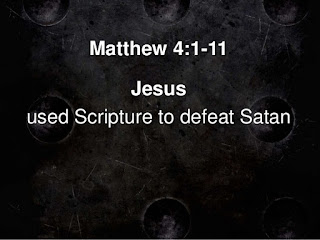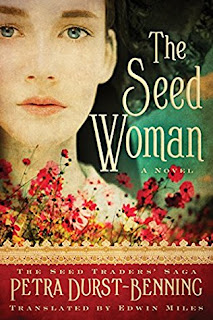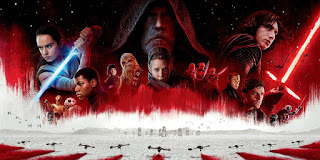Matthew is the first book of the New Testament and the first
Gospel of Jesus Christ. Matthew was one of the twelve disciples who was a tax
collector named Levi before Jesus called to follow him. His purpose in writing
this gospel was to prove that Jesus is the Messiah, the eternal King especially
to the Jews as he begins with the genealogy of Jesus from Abraham to David to
his earthly father, Joseph. Jesus began his ministry at the age of 30 and
taught nonstop for three years. With so much information and lesson in this
book alone that I could discuss, I wasn’t sure what to discuss. I will discuss
four segments which spoke to me as I read it. Illustration in how to fight
temptation, a lesson in prayer, a lesson in what is required to follow Christ
and a command to remain watchful and prepare for his second coming.

First, Satan tempts Jesus in the desert in Matthew 4:1-11. Jesus
was led by the Spirit into the desert where he’d be tempted by the devil (verse
1). After he fasted for 40 days and 40 nights (verses 2), Satan arrived with
the first of three temptations. The first temptation was “If you are the Son of
God, tell these stones to become bread” (verse 3). Since Jesus has fasted, he
was incredibly hungry and this would be a great temptation. Jesus answers “It
is written: ‘Man does not live on bread alone, but on every word that comes
from the mouth of God’” (verse 4). This is in reference to Deuteronomy
8:3. Temptation number 2, Satan takes
Jesus to the highest point on the temple and says “If you are the Son of God,
throw yourself down. For it is written: ‘He will command his angers concerning
you, and they will lift you up in their hands, so that you will not strike your
foot against a stone’” (verse 5-6). Satan is referring to Psalm 91:11-12. Jesus
answers “It is also written: ‘Do not put the Lord your God to the test’” (verse
7) which is referring to Deuteronomy 6:16. The final temptation is when Satan
takes Jesus to a very high mountain from which they can see all kingdoms and
splendor, “All this I will give you, if you will bow down and worship me”
(verses 8-9). Jesus’s reply is swift “Anyway from me, Satan! For it is written:
‘Worship the Lord your God and serve him only’” (verse 10), referring to
Deuteronomy 6:13. What’s the point? First, Satan knows the Word of God too. So
just because someone has biblical knowledge doesn’t mean he or she is a true
believer. Second, Jesus responds with the Word of God, giving us an example why
it is important that we know the Word too. It is our best defense against
temptations.

Second, Jesus teaches about prayer in Matthew 6:5-13. First,
he tell us to pray unseen (verse 5). Do not make a spectacle or a big
production about it. I am reminded of this verse when people argue that we need
prayer back in schools. I say prayer never left because prayers are still being
said in schools today. It is just not a school led activity and it shouldn’t
be. Prayer is a private act of worship. There are different examples of when
prayer is said aloud like in church or as a family at dinner; however, overall,
prayer is a private petition between God and a believer. Second, Jesus tells us
that before we ask, the Lord already knows what we need, so there’s no need to
babble with many words (verses 7-8). He then gives us a prayer that is known as
The Lord’s Prayer (verses 9-13). “Our Father in heaven, hallowed be your name”
(verse 9) acknowledges God’s holiness as well as his personal and loving
relationship with us. “Your kingdom come, your will be done, on earth as it is
in heaven” (verse 10) is a reference to God’s spiritual reign as well as
praying that God’s purpose be enacted in this world as it is done in heaven.
“Give us today our daily bread” (verse 11) acknowledges that God is our
provider of all we have. “Forgive us our debts, as we also have forgiven our
debtors” (verse 12) asks God to forgive us as we forgive others. “Debts” would
be sins not just financial debts but hurts and wrongs done against God and
against us. “And lead us not into temptation, but deliver us from the evil one’
(verse 13) is asking for God’s protection against temptation, to recognize it
when we will inevitably come across it. When you pray the Lord’s Prayer, think
about what each verse means and feel the power and importance in those words.
There’s great meaning in this simple prayer.

Third, Jesus eats with sinners at Matthew’s house in Matthew
9:9-13. These verses tell the story of how Matthew is called by Jesus to follow
him and he does (verse 9). Matthew had a dinner at his house for Jesus, his
disciples and other “sinners” (quotations appear in my Bible) (verse 10). The Pharisees
(a Jewish religious group that avidly followed the Old Testament laws) saw this
and asked why Jesus was eating with such men? Jesus replied “It is not the
healthy who need a doctor, but the sick. But go and learn what this means ‘I
desire mercy, not sacrifice.’ For I have not come to call the righteous, but
sinners” (verse 12-13). “I desire mercy, not sacrifice” is in reference to
Hosea 6:6 when God didn’t want just the rituals, he wanted the people’s hearts.
The rituals were more than just actions to appease God, there are ways to
connect with God. When a ritual is done without one’s heart, the ritual becomes
empty and a mockery. Like going through the motions because of habit or you are
required do, rather than because you want and need to. Like a Catholic who goes
to Confession because it’s the day to do so rather than the need to seek
forgiveness. By using this verse, Jesus is stating that he is more concerned
with the people who need him, need forgiveness, need guidance especially the
hurting and sinful ones and not appearances and the righteous. In order to
reach those who need him, he needed to meet them where they are, eat with them,
and teach them. With Jesus, you do not need to change before you can accept him
as Lord and Savior. Follow him and he will help you do the changes needed. For
Jesus said “Come, follow me” (Matthew 4:19). He didn’t say “change your life,
then follow me.” No, he said come. Come as you are.

Lastly, Jesus spoke about being watchful in Matthew
24:36-51. In these verses, he speaks about being watchful for his return because
no one knows when that will be. Right off the bat in verse 36, he says “NO ONE
knows about that day or hour, not even the angels in heaven, not the Son, but
only the Father” (emphasis mine). So when someone claims to have the date that
Christ will come and begin the end of days, pay him no mind because if God the
Father doesn’t even tell his Son when that day will be, why would he tell a
someone on Earth? Not knowing the date, keeps believers on their toes and
continuing their work for Christ as they prepare and await his return. If we
knew the date, wouldn’t we be lazy and wait until the date approaches to
believe or spread the Word? In verses 40-41, Christ speaks about some people
being taken and others being left behind. These verses are to illustrate how
shift his second coming will be, Jesus commands us to keep watch (verse 42).
And just as a homeowner doesn’t know when the thief will come to his house, we
are to prepare for Jesus, as we do not know when he will come back (verse
43-44). Keeping watch and preparing for his coming doesn’t mean that believers
can hoard food and hunker down in a bunker in the wilderness somewhere. No, it
means to continue our work for Christ and live as if today will be our last.
When the opportunity arises to share Christ’s love and gift of salvation, do
so. When the opportunity arises to help your fellow man, extend your hand as
Christ would. It doesn’t mean always mean money handouts for the needy. It
includes acts of mercy to those who need it. Simple acts of kindness and love. As
Christ said “whatever you did for one of the least of these brothers of mind,
you did for me” (Matthew 25:40) and “whatever you did not do for one of the
lease of these, you did not do for me” (Matthew 24:45). For you don’t know when
Christ will return, our job isn’t done yet.

In conclusion, the gospel of Matthew is the longest book of
the gospels. Jesus taught nonstop in the three years of his ministry whether it
was to the disciples in a quiet place or to the crowds in a public place, he
taught. It is an example for us. We don’t all need to be a pastor at the pulpit
to spread God’s word. We are to know the Bible in order to fight temptation as
Christ used the Bible to ward off Satan’s temptations. We are to pray with
meaning, with faith and in a quiet place. We are to come to Christ as we are
and as we live to follow his words, he will change us to be more like him. As
followers of Christ, we are to continue to do his work here until his second
coming. There are moments in our everyday lives in which we can extend Christ’s
love to those who desperately need it.












































